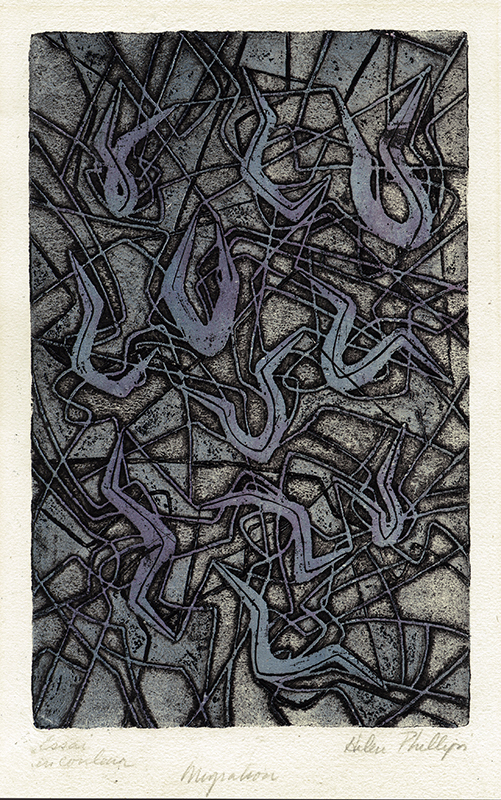
19th, 20th & 21st Century Fine Prints
707-546-7352 · fax 707-546-7924 · web: www.annexgalleries.com · email: artannex@aol.com
Migration by Helen Elizabeth Phillips

Migration
Helen Elizabeth Phillips
Migration
Helen Elizabeth Phillips
1913 - 1994 (biography)This open bite etching with aquatint is a color proof in violet and gray-green. Migration was done at Atelier 17 in New York while the artist was married to Atelier 17 founder S.W. Hayter. The heavy dark, deeply etched lines and skeletal structures, interlacing each other, add a three dimensional, sculptural element to the composition. Phillips was best known as a sculptor and her prints reflect that interest.
Helen Elizabeth Phillips Hayter, sculptor and printmaker, was born in Fresno, California on March 3, 1913. She studied at the California School of Fine Arts (CSFA; now the San Francisco Art Institute) between 1932 and 1936. While there, she met visiting artist Diego Rivera, whose collection of Mexican sculpture would leave a lasting impression on the young student and change the course of her studies. In 1936 Phillips won the San Francisco Museum Purchase Prize for her stone carving, "Young Woman," which remains a part of the SFMOMA's permanent collection. That same year, she was awarded a Phelan Traveling Fellowship to travel to and study in Italy and France. While living in Paris as winter approached, the cold weather made carving stone difficult and she looked for an alternative medium to focus on.
After learning about Atelier 17 from artists she'd come to know in Paris, she entered the experimental intaglio workshop founded by Stanley William Hayter to try her hand at printmaking. There, she was able to work alongside Europe's leading Modernists: Pablo Picasso, Joan Miro, Max Ernst, and many others. Phillips produced a prolific body of Surrealist and Abstract Expressionist intaglio prints that expanded her knowledge of the use of negative space, a crucial aspect of her future sculpture. A quote from Carla Esposita-Hayter's dossier on Phillips reads: "'Engraving is the same thing', she said when asked to comment on its bearing on sculpture, 'except it is so quick, you can experiment.'" In 1937 Phillips returned to San Francisco to accept a commission for three figural sculptures that would flank a major fountain at the 1939 Golden Gate International Exhibition.
She returned to Paris in 1938 and one year later she and Hayter, now a couple, left Paris for London after Hayter was called up to serve his country as World War II loomed. After the invasion of Paris by Germany, Phillips' work from her time there - abandoned as with many artists' works due to the fear of invasion - was largely lost to bombing (though some would later be salvaged by Peggy Guggenheim). At the end of 1939 Hayter left on the last ship bound for New York while Phillips, now pregnant with their first son, returned directly to San Francisco. Hayter would follow her soon thereafter. In 1940 Phillips exhibited at the San Francisco Museum of Art, and in June she and Hayter married and moved to New York, where they would re-establish Atelier 17 in Manhattan.
Phillips had her first solo exhibition in 1941 at the New School for Social Research, and participated in the major exhibtion Surrealism organized by Roberto Matta the same year. Her reputation as a sculptor set her on par with the leading Surrealists and Abstract Expressionists of the time, and earned her write-ups in the influential Surrealist publication Tiger's Eye and elsewhere. She continued to work in intaglio printmaking as well and participated in the first of several joint exhibitions with Hayter at the Sidney Janis Gallery in 1949. In 1950 Hayter decided to return to Paris to re-establish Atelier 17 once again in his adopted city, and Phillips followed.
Meanwhile, she continued to work in printmaking, now integrating lithography and large-scale linoleum cuts to her body of work, as well as color viscosity printmaking, the signature experimental medium of Atelier 17. In 1956 she and Hayter held a joint exhibition at the Achenbach Foundation in San Francisco. In 1960 Phillips returned to San Francisco to teach at the San Francisco Art Institute, and began dividing her time between the U.S. and France. After her divorce from Hayter in 1972 she continued to work in New York and Paris and in the summer months she frequented the foundry of Santa Pietra, Italy. In 1988 she was the subject of a documentary by the BBC titled "American Sculptor Helen Phillips, Paris Studio". Helen Phillips died in Greenwich Village in New York City on January 22, 1994.
